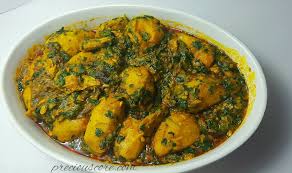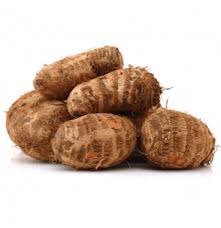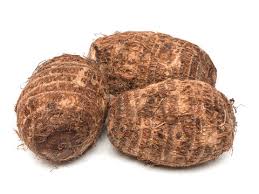Cocoyam, scientifically known as Colocasia esculenta and commonly referred to as taro, is a root vegetable widely cultivated in tropical and subtropical regions. This versatile tuber has been an integral part of various cultures for centuries, not only serving as a staple food but also as a source of nutrition and health benefits.
Cocoyam is known for its distinctive flavor and texture, making it a favorite ingredient in many dishes. The culinary uses of cocoyam are diverse, ranging from traditional recipes to modern gourmet creations.
It can be boiled, baked, mashed, or fried, and is often used as a substitute for potatoes in various recipes. In many countries, cocoyam is prepared in soups, stews, and curries, providing a rich, creamy consistency that enhances the overall taste of the dish.
Beyond its culinary significance, cocoyam holds considerable nutritional value. It is a good source of carbohydrates, vitamins, and minerals, making it an essential food for many communities. Cocoyam is rich in dietary fiber, which aids digestion and promotes gut health.
The presence of vitamins such as vitamin C and several B vitamins contributes to overall health, supporting the immune system and helping to maintain energy levels. Additionally, cocoyam contains minerals like potassium, magnesium, and iron, which are vital for various bodily functions, including muscle contractions and oxygen transport.
Cocoyam is not only appreciated for its nutritional benefits but also for its medicinal properties. Traditionally, it has been used in herbal medicine to treat a variety of ailments. In some cultures, the leaves and stems of cocoyam are utilized for their anti-inflammatory and antioxidant properties.
These parts of the plant are sometimes prepared as herbal teas or poultices to relieve conditions such as arthritis and skin irritations. The rich phytochemical content of cocoyam has attracted the interest of researchers, leading to studies on its potential health benefits, including its role in managing chronic diseases like diabetes and heart disease.
In addition to its health and culinary applications, cocoyam plays a significant role in agricultural practices and sustainable farming. It is often grown in wetland areas, contributing to soil health and preventing erosion.
The plant’s ability to thrive in marginal soils makes it a valuable crop in regions facing food security challenges. Cocoyam farming can also provide a livelihood for smallholder farmers, as it is relatively easy to cultivate and requires less input compared to other cash crops.
Cocoyam’s cultural significance cannot be overlooked either. In many communities, it is a symbol of hospitality and is often featured in traditional celebrations and ceremonies. Its preparation and consumption can be a communal activity, fostering social bonds and cultural heritage. Furthermore, cocoyam is sometimes used in religious rituals, showcasing its importance beyond just being a food source.
Nutritional Benefits of Cocoyam
1. Rich in Carbohydrates: Cocoyam is a good source of complex carbohydrates, providing energy and promoting stable blood sugar levels.
2. High Dietary Fiber: The fiber content aids digestion, helps maintain gut health, and can assist in weight management by promoting a feeling of fullness.
3. Vitamins and Minerals: Cocoyam is packed with essential vitamins such as vitamin C and several B vitamins (including B6 and folate), along with important minerals like potassium, calcium, and magnesium.
4. Antioxidant Properties: The presence of antioxidants in cocoyam helps combat oxidative stress, reducing the risk of chronic diseases.
5. Gluten-Free: Cocoyam is naturally gluten-free, making it an excellent alternative for those with gluten sensitivities or celiac disease.
Culinary Applications of Cocoyam

1. Versatile Ingredient: Cocoyam can be boiled, mashed, roasted, or fried, making it a versatile ingredient in various dishes.
2. Popular in Soups and Stews: It is commonly used in soups and stews as a thickening agent, adding a unique flavor and texture.
3. Cocoyam Flour: Dried and ground cocoyam can be used to make flour, which can serve as a gluten-free alternative for baking and cooking.
4. Snacks and Chips: Cocoyam can be sliced thinly and fried or baked to create healthy snacks and chips, often enjoyed with dips.
5. Traditional Dishes: Many cultures incorporate cocoyam into traditional dishes, highlighting its significance in regional cuisines.
Cocoyam in Traditional Medicine
1. Digestive Health: Traditionally, cocoyam is used to treat digestive issues due to its high fiber content, promoting gut health and alleviating constipation.
2. Anti-inflammatory Properties: The roots and leaves of cocoyam are believed to possess anti-inflammatory properties, which may help in reducing inflammation-related conditions.
3. Wound Healing: In some cultures, cocoyam leaves are used as poultices to promote wound healing and alleviate skin irritations.
4. Nutritional Support: Cocoyam is sometimes recommended for individuals recovering from illness or surgery due to its rich nutrient profile, aiding in overall recovery.
5. Traditional Remedies: Various traditional remedies utilize cocoyam to address ailments such as respiratory issues, fever, and other common health concerns.
Cocoyam as Animal Feed
1. Nutrient-Rich Feed: Cocoyam leaves and tubers are nutritious and can serve as feed for livestock, contributing to their overall growth and health.
2. Energy Source for Animals: The high carbohydrate content provides a good energy source for ruminants and other livestock, supporting their daily energy needs.
3. Palatability: Animals generally find cocoyam palatable, which encourages feed intake and can improve feed efficiency.
4. Sustainable Feed Option: Using cocoyam as animal feed can help reduce waste, as the leaves and tubers that may not be suitable for human consumption can be utilized for livestock.
5. Cost-Effective Alternative: Incorporating cocoyam into animal feed can be a cost-effective strategy for farmers, particularly in regions where cocoyam is abundantly grown.
Read Also: 7 Medicinal Health Benefits of Daffodils (Narcissus Plant)
Cocoyam for Starch Production

1. Starch Content: Cocoyam is known for its high starch content, making it an excellent raw material for starch extraction, which can be used in various food and industrial applications.
2. Extraction Process: The starch is extracted by washing, peeling, and grinding the cocoyam tubers, followed by sieving and washing to remove impurities, leaving behind pure starch.
3. Applications of Cocoyam Starch: The starch obtained from cocoyam can be used as a thickening agent in sauces, soups, and gravies, as well as in the production of gluten-free products.
4. Industrial Uses: Beyond food, cocoyam starch can be used in the paper, textile, and pharmaceutical industries as a binding agent and stabilizer.
5. Nutritional Benefits: Cocoyam starch is a complex carbohydrate that provides energy, making it a valuable ingredient in both human and animal diets.
Cocoyam in Baking and Food Processing
1. Gluten-Free Alternative: Cocoyam flour is an excellent gluten-free substitute in baking, suitable for individuals with celiac disease or gluten intolerance.
2. Nutrient-Rich Flour: The flour retains much of the nutritional profile of the cocoyam, providing essential vitamins and minerals while enhancing the nutritional value of baked goods.
3. Versatile Ingredient: Cocoyam can be used in various recipes, including bread, muffins, pancakes, and pastries, adding a unique flavor and texture.
4. Thickening Agent: In food processing, cocoyam flour can serve as a natural thickener in sauces, gravies, and soups, improving mouthfeel and consistency.
5. Enhanced Flavor: Incorporating cocoyam into baked products can enhance flavor profiles, providing a slightly sweet and earthy taste that pairs well with other ingredients.
Cocoyam as a Source of Dietary Fiber
1. High Fiber Content: Cocoyam is rich in dietary fiber, which is essential for maintaining healthy digestion and regular bowel movements.
2. Weight Management: The fiber content in cocoyam helps promote satiety, which can assist in weight management by reducing overall food intake.
3. Heart Health: A high-fiber diet is associated with a reduced risk of cardiovascular diseases, and incorporating cocoyam can contribute to heart health by lowering cholesterol levels.
4. Blood Sugar Control: The fiber in cocoyam helps regulate blood sugar levels by slowing down the absorption of sugars, making it beneficial for individuals with diabetes.
5. Gut Health: Dietary fiber supports a healthy gut microbiome by providing nourishment for beneficial gut bacteria, which can improve overall digestive health.
Cocoyam in Soups and Stews
1. Natural Thickener: Cocoyam is often used in soups and stews as a natural thickening agent, enhancing the texture and creaminess of the dish.
2. Nutrient Booster: Adding cocoyam to soups and stews increases the nutritional content, providing essential vitamins, minerals, and dietary fiber.
3. Flavor Enhancement: Cocoyam contributes a unique flavor and aroma to soups and stews, enriching the overall taste profile of the dish.
4. Versatile Ingredient: It can be incorporated into a variety of soup and stew recipes, making it a versatile ingredient in traditional and modern culinary practices.
5. Comfort Food: Dishes made with cocoyam are often regarded as comfort food, providing warmth and nourishment, especially in colder climates or during illness.
Cocoyam Flour for Gluten-Free Baking
1. Gluten-Free Alternative: Cocoyam flour is a popular choice for gluten-free baking, providing a safe option for individuals with celiac disease or gluten intolerance.
2. Nutritional Benefits: It contains essential nutrients, including vitamins A and C, calcium, and iron, making baked goods not only gluten-free but also nutritious.
3. Unique Texture and Flavor: Cocoyam flour imparts a slightly sweet and earthy flavor to baked products, enhancing their taste while adding moisture.
4. Versatility in Recipes: It can be used in a variety of recipes, including bread, cookies, pancakes, and muffins, allowing for creative gluten-free options.
5. Improved Digestibility: The flour is easier to digest compared to some other gluten-free flours, making it suitable for individuals with digestive issues.
Read Also: Bacterial Canker (Stone fruit trees): Description, Damages Caused, Control and Preventive Measures
Cocoyam in Baby Food Preparation

1. Nutrient-Dense Option: Cocoyam is rich in carbohydrates, vitamins, and minerals, making it an excellent ingredient for nutritious baby food.
2. Easy to Digest: The soft texture of cooked cocoyam makes it easy for babies to digest, reducing the risk of gastrointestinal discomfort.
3. Simple Preparation: Cocoyam can be easily cooked, mashed, and combined with other fruits and vegetables to create healthy purees for infants.
4. Allergy-Friendly: It is a hypoallergenic food, making it a safe choice for babies with food allergies or sensitivities.
5. Cultural Traditional Use: In many cultures, cocoyam has been used for generations in the preparation of baby food, reflecting its importance in traditional diets.
Cocoyam for Cultural and Ritual Significance
1. Traditional Practices: Cocoyam holds cultural significance in various communities, often used in traditional ceremonies, rituals, and celebrations.
2. Symbol of Fertility: In some cultures, cocoyam is associated with fertility and abundance, making it a staple in fertility rites and agricultural festivals.
3. Offerings and Sacrifices: Cocoyam is commonly used in religious offerings and sacrifices, symbolizing respect and gratitude to deities.
4. Community Gatherings: The preparation and sharing of cocoyam dishes during community events foster social bonds and cultural heritage.
5. Culinary Heritage: Cocoyam recipes passed down through generations showcase the culinary traditions and identity of specific cultures.
Cocoyam in Snack Production
1. Healthy Snack Option: Cocoyam can be processed into various snacks, such as chips, crackers, and flour-based snacks, providing a nutritious alternative to conventional snacks.
2. Rich Flavor: The unique flavor of cocoyam enhances the taste of snacks, making them more appealing to consumers looking for healthy options.
3. Versatile Ingredient: It can be combined with different seasonings and ingredients to create diverse snack products that cater to various palates.
4. Nutritional Fortification: Cocoyam snacks can be fortified with additional nutrients, offering health benefits while satisfying cravings.
5. Market Demand: The growing trend towards healthy snacking presents an opportunity for cocoyam-based products in the market, attracting health-conscious consumers.
Cocoyam for Soil Improvement and Erosion Control
1. Soil Enrichment: Cocoyam contributes organic matter to the soil, enhancing soil fertility and structure through decomposition.
2. Erosion Prevention: The extensive root system of cocoyam helps bind the soil, reducing erosion and maintaining soil integrity on slopes and vulnerable areas.
3. Nutrient Cycling: When incorporated into crop rotations, cocoyam can improve nutrient cycling, benefiting subsequent crops by replenishing soil nutrients.
4. Weed Suppression: The growth of cocoyam can suppress weeds, minimizing the need for chemical herbicides and promoting sustainable farming practices.
5. Biodiversity Promotion: Growing cocoyam alongside other crops enhances biodiversity in agricultural systems, improving ecosystem resilience and health.
Do you have any questions, suggestions, or contributions? If so, please feel free to use the comment box below to share your thoughts. We also encourage you to kindly share this information with others who might benefit from it. Since we can’t reach everyone at once, we truly appreciate your help in spreading the word. Thank you so much for your support and for sharing!
Read Also: Relationship Marketing Process and Approaches to the Study of Marketing

